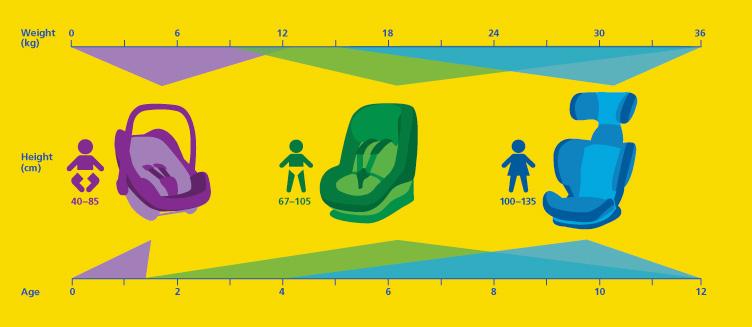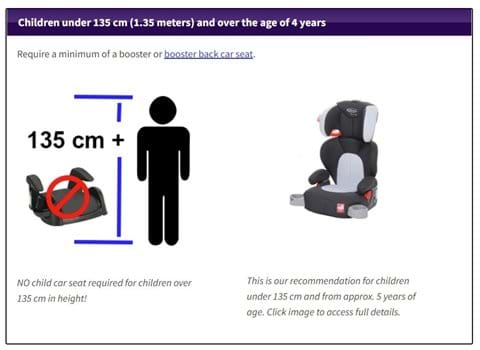Using Car Seats in Spain
Car Seats in Spain: Understanding the Law
Even if you’re just visiting Spain for a couple of weeks in the summer, it’s imperative to know the law on child seats and seat belt use. The laws are there to protect you and your passengers. Failure to comply could result in a hefty fine or, much worse, an injury to one of your loved ones.
In Spain, all drivers and any passengers travelling along urban roads or highways in a motorized vehicle are legally required to wear a properly fastened seat belt and/or child restraint. It’s prohibited for children under 12 to travel in the front seat unless they are in a car seat designed specifically for that purpose, or they are at least 135 centimeters tall, in which case they are allowed to use an adult seat belt. Those measuring less than 135 centimeters in height must use an approved child seat or harness, suitable and appropriate for their height and weight, while those measuring between 135 and 150 centimeters can use either an approved child restraint or the adult seat belt.
These rules have been set out in the Spanish General Traffic Regulations and any failure to comply is regarded as a serious offence punishable by 200 euro fine (or 260 euro for a repeat offence) plus 3 points off your license. For the purposes of this law, it is the driver who is primarily responsible, followed by the owner of the vehicle who has subsequent responsibility.
Currently, the Prosecutors’ Office for the Protection of Minors has the power to suspend parental guardianship or enforce protective measures if parents are punished three times or more for failing to use adequate child protection restraints in a vehicle.
Using the Correct Car Seats in Spain for your child.
The car seat should correspond to the height and weight of the child and be an EU approved design and make. Car seats are classified into groups 0, 0+, 1, 2 and 3 with some seats covering more than one group. The back of the car seat should be clearly labelled with the name of the manufacturer along with data showing compliance with the most recent legally required standards (currently ECE R44/04), upper and lower weight limits for the child and the seat’s serial number.


Group 0 Carriers (from 0 to 10 kg and less than 76 cm)
Infant carriers / carry cots designed specifically for newborns and babies weighing up to 10 kilos. These must be installed in the back seat of the vehicle, transversely along the seat with the baby’s head facing into the car to best protect him or her in the event of a side impact collision.
Group 0 and 0+ Child Seats (from 0 to 13 kg and less than 92 cm)
Car seat designed to be used in the back seat of the vehicle, or the front seat but only if there is no passenger airbag or it is disconnected. These seats are always rear facing. Baby is protected by the integrated harness and the child seat is anchored to the vehicle.
Group 1 Child Seat (9 to 18 kg and from 92 to 108 cm)
In a Group 1 Child Seat, the child is attached to the chair and the car (via a harness). These chairs can be forward facing or rear facing. It is very important to adjust the seat as the child grows to avoid any gaps in the harnesses and seat belt installation. It’s possible to use an Isofix anchor with Group 1 seats.
Group 2 Child Seat (15 to 25 kg and from 98 to 123 cm)
This booster seat with back support enables the vehicle’s 3-point seat belt to be adjusted to secure the child, fitting snugly to his or her body. The child can travel facing forward in the front seat or the back.
Group 3 Child Seat (22 to 36 kg and 115-150 cm)
This booster seat can be used forward facing in the front or back seat of the vehicle.
It’s best to leave it as long as possible before moving your child up to the next group of car seats. During the period when their weight overlaps the two groups, babies are much safer travelling in a Group 0+ car seat than in a Group 1.
Additionally, it’s recommended that you use a Group 2 booster seat with backrest until the child measures 135 centimeters or above, as long as this is possible within the usage guidelines for your chosen seat.
IMPORTANT TIP: Ensure you order the correct car seat for your child at the time of making a car hire reservation. Last minute child car seats are not always easy to find and it can be a stressful start to your journey.




Read more comments →